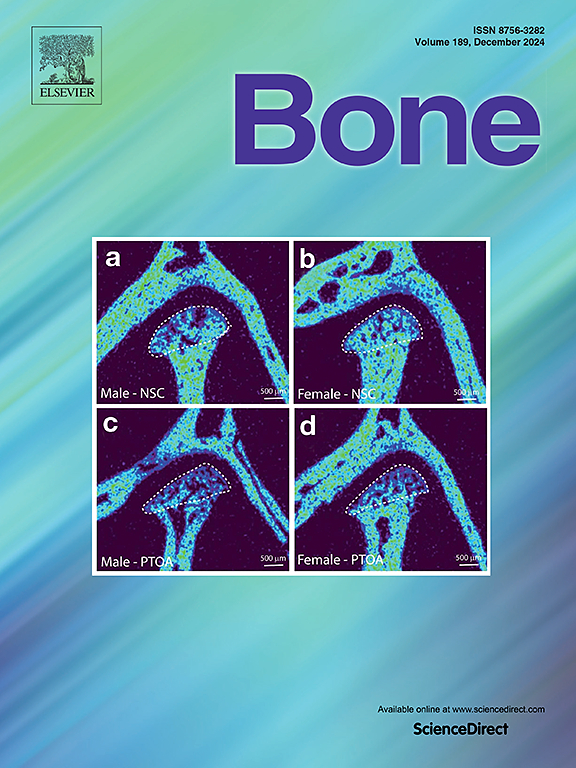惰性全身性肥大细胞增多症椎体骨折的数量受kit突变的影响。
IF 3.6
2区 医学
Q2 ENDOCRINOLOGY & METABOLISM
引用次数: 0
摘要
系统性肥大细胞增多症(SM)是一种罕见的疾病,其特征是肥大细胞聚集在皮肤或皮外器官。疾病亚型范围从皮肤到系统性肥大细胞增多症与高度恶性形式,惰性系统性肥大细胞增多症(ISM)是最常见的亚型。ISM患者肥大细胞浸润骨髓,部分患者出现骨质疏松和骨折。然而,并非所有ISM患者都发生骨折。在这项回顾性单中心研究中,我们分析了2006年至2019年间根据世卫组织标准被诊断为ISM的骨质疏松症患者的数据。ISM病人(n = 42)由76.2 % (n = 32),女性的平均年龄52.2 ± 12年,并与皮肤损伤提出了在80.5 % (n = 33)。42 % (n = 15)根据WHO定义诊断为骨质疏松症(t评分 ≤ -2.5)。19 % (n = 8)发生外周骨折,43 % (n = 18)发生脊柱骨折;两种骨折类型均出现在14 % (n = 6)。所有骨折类型均与股骨骨密度t评分相关。骨活检中存在KIT受体酪氨酸激酶(KIT-突变)的体细胞功能获得突变与骨折数量显著增加相关(p = 0.024),并与个体患者椎体骨折数量相关(p = 0.03)。胰蛋白酶水平、绝经后状态和骨转换标志物都不是ISM患者椎体或外周骨折增加的指标。吸烟与骨折的发生有关,但这种影响随着kit突变而消失。有皮损者股骨BMD t评分较好(右股骨:-1.05 ± 0.99 vs -2.26 ± 0.59,p = 0.008;右股骨颈:-1.21 ±0.99 vs -2.22 ± 0.55,p = 0.0023)。总之,我们证明了kit突变对最终诊断为ISM的骨质疏松症患者骨折严重程度的影响。我们的研究结果表明,在没有皮肤病变的ISM患者中存在kit突变,及时开始抗骨质疏松治疗可能是有价值的。本文章由计算机程序翻译,如有差异,请以英文原文为准。
The number of vertebral fractures in indolent systemic mastocytosis is influenced by presence of the KIT-mutation
Systemic mastocytosis (SM) is a rare disease characterized by aggregation of mast cells in the skin or extracutaneous organs. Disease subtypes range from cutaneous to systemic mastocytosis with highly malignant forms, indolent systemic mastocytosis (ISM) being the most frequent subtype. In ISM, mast cells infiltrate bone marrow, with some patients developing osteoporosis and fractures. However, fractures do not occur in all ISM patients.
In this retrospective one-center study, we analyzed data from patients evaluated for osteoporosis diagnosed with ISM according to WHO criteria between 2006 and 2019. ISM patients (n = 42) comprised 76.2 % women (n = 32), had a mean age of 52.2 ± 12 years, and presented with skin lesions in 80.5 % (n = 33). Osteoporosis was diagnosed in 42 % (n = 15) according to the WHO definition (T-score ≤ −2.5). Fractures were either peripheral in 19 % (n = 8), or to the spine in 43 % (n = 18); both fracture types presented in 14 % (n = 6). All fracture types correlated to femoral BMD T-scores. The presence of the somatic gain-of-function mutation in the KIT receptor tyrosine kinase (KIT-mutation) in bone biopsy was associated with a significantly greater number of fractures (p = 0.024) and correlated to the number of vertebral fractures in individual patients (p = 0.03). Neither tryptase levels, postmenopausal status, nor bone turnover markers were indicators of an increase in vertebral or peripheral fractures in ISM patients. Smoking was associated with more fractures, however the effect disappeared dependent on KIT-mutation. Those with skin lesions had better femoral BMD T-scores (right femur: −1.05 ± 0.99 vs −2.26 ± 0.59, p = 0.008; right femoral neck: −1.21 ± 0.99 vs −2.22 ± 0.55, p = 0.0023).
In conclusion, we demonstrate the influence of the KIT-mutation on the severity of fractures in osteoporosis patients with the final diagnosis of ISM. Our results suggest that, in the presence of the KIT-mutation in ISM patients without skin lesions, the timely onset of anti-osteoporotic treatment might be of value.
求助全文
通过发布文献求助,成功后即可免费获取论文全文。
去求助
来源期刊

Bone
医学-内分泌学与代谢
CiteScore
8.90
自引率
4.90%
发文量
264
审稿时长
30 days
期刊介绍:
BONE is an interdisciplinary forum for the rapid publication of original articles and reviews on basic, translational, and clinical aspects of bone and mineral metabolism. The Journal also encourages submissions related to interactions of bone with other organ systems, including cartilage, endocrine, muscle, fat, neural, vascular, gastrointestinal, hematopoietic, and immune systems. Particular attention is placed on the application of experimental studies to clinical practice.
 求助内容:
求助内容: 应助结果提醒方式:
应助结果提醒方式:


